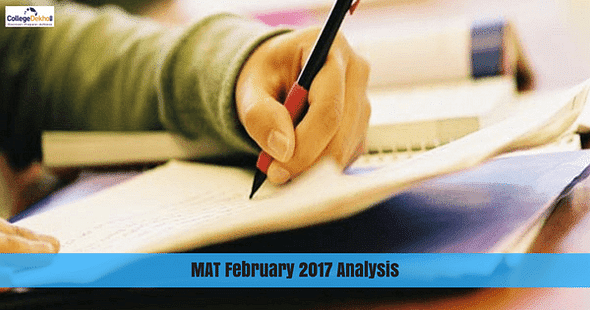MAT 2017 computer based test (CBT) held on February 11, 2017. Here is a detailed analysis of the exam.

MAT 2017 computer based test (CBT) was conducted on February 11, 2017, by AIMA. Over 20000 candidates appeared for Management Aptitude Test (MAT) February 2017. The exam was conducted in a single session and the score is accepted by more than 300 Business schools across India. The exam pattern remained similar to that in 2016. The difficulty level of MAT February 2017 was more or less the same as that of MAT December 2016.
The exam was conducted in both paper-pencil mode and online mode. The paper pencil based test was held on February 5, 2017.
MAT 2017 February test: Brief analysis
Although there were no surprise elements in the question paper, Critical Reasoning and Data Analysis & Sufficiency sections were a bit trickier than the rest of the sections. Indian & Global Environment section also had a few tough questions that candidates might have found confusing. The overall difficulty level of MAT February 2017 exam was moderate.
There are total 5 sections in MAT, each comprising 40 questions:
- Data Analysis and Sufficiency
- Language Comprehension
- Mathematical Skills
- Intelligence and Critical Reasoning
- Indian and Global Environment
The question paper comprised a total of 200 multiple choice questions and the duration of the exam was 150 minutes. Data Analysis and Sufficiency section was a bit more time-consuming and students struggled to keep up with the time limit in attempting the minimum number of questions to clear the threshold.
Each question of the exam carried equal marks and for every correct answer, candidates will be awarded 1 mark whereas 0.25 marks will be deducted for every incorrect answer. Percentile is evaluated by normalizing the raw score achieved after the first evaluation. The raw score is scaled and then after normalization process is converted to percentile. 4 sections of the exams sum up to a total score of 800 marks excluding the Indian & Global environment section.
The sections wise analysis- MAT Feb 2017
1. Language Comprehension
The section comprised 20 Verbal Ability/ Reasoning questions along with 20 questions based on Reading Comprehension. The Reading Comprehension comprised of 4 passages, each having 5 questions. The passages were approximately 500-600 words long. Most of the questions based on reading comprehension were straight forward with a mild difficulty level. Certain questions were asked to analyze a student's reasoning abilities .
The VA/VR questions included:
- Para-jumbles questions each having 5 sentences
- Grammar questions
- Sentence completion with double blanks
- Questions on finding the essence of text/main idea of text
Overall, the section was easy with a few moderately difficult questions. Attempting close to 25 questions with 85% accuracy will result in a good score in this section.
2. Intelligence and Critical Reasoning
Questions were asked from areas like Verbal Reasoning and Logical Reasoning. Course of Action, Statement-conclusion, Cause/Effect types and Reason and Assertion were some of the type of questiones asked in this section.
Questions in this section can be rated on a scale of easy to moderate. Some set-based questions were also seen in this section. Other topics asked in this section included Venn diagrams, Complete the series, Family tree (standalone questions), Linear equations, Cubes (Visual Reasoning), Remainder Directions (standalone questions), Matrix arrangement (2 sets of 5 questions each) and Circular arrangement (1 set of 5 questions).
Attempting 30 questions from this section in 35 minutes will be considered a good performance.
3. Mathematical Skills
Out of the 40 questions asked in this section, 25 questions were from Arithmetic that required relatively heavier calculation. However, the difficulty level of this section could be rated between easy and moderate.
topics from which questions were asked in this section were Time and work, Pipes and Cisterns, Time-Speed-Distance, Percentages, Mixtures, Simple and Compound Interest, Profit and Loss, Probability, Algebraic Equations, Geometry, Permutation & Combination, Trigonometry, Mensuration etc. Attempting around 20-21 questions in 35-40 minutes with approximately 85% accuracy will result in a good score in this section.
4. Data Analysis (Interpretation) and Data Sufficiency
The Data Interpretation section had 6 sets with 5 questions each. This was a time-consuming section as the calculation were heavy. Questions on Quantitative Comparison and Data Sufficiency were asked in this section. Data Analysis (Interpretation) and Data Sufficiency questions were asked from topics like Bar Graph, Line Graph, Pie Charts, Caselet, Quantitative Comparison, etc.
By attempting 23-24 questions in 35 minutes with an accuracy of 85%, the results will be fruitful.
5. Indian and Global Environment
This section comprised questions related to current events of the recent months. The questions were varried in domain including current economic and political scenarios of India and abroad. The section was moderately difficult and attempting 25-26 questions in 15 minutes will ensure a good score considering that the accuracy was 80%.
Overall, the test was of easy to moderate level of difficulty side and a score of around 600 or more would be good score to get call from most of the B-school accepting MAT score.
All the best.

















Similar Articles
CMAT Normalization Process 2025: How Scores are Calculated?
CMAT Merit List 2025: Check Marks & NTA Score, Toppers, All India Rank (AIR)
MBA Colleges for Low Percentile/ Score in CMAT 2025
MBA Colleges for 300-320 Marks in CMAT 2025
List of MBA Colleges Accepting 60-70 Percentile in CMAT 2025
List of MBA Colleges Accepting 50-60 Percentile in CMAT 2025